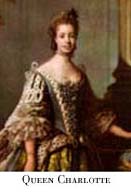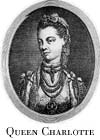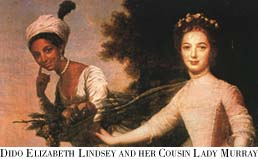


Author’s note: This article, originally written in 1997, was updated on March 11, 2021 with clarifications and to remove outdated language around race.
With features reputed to be conspicuously African by her contemporaries, it is no wonder that the Black community, both in the U.S. and throughout the British Commonwealth, has rallied for generations around depictions of Queen Charlotte, portrayed as she usually is in the regal and sumptuous splendor of her coronation robes.
Queen Charlotte (1744-1818), wife of the English King George III (1738-1820), was directly descended from Margarita de Castro y Sousa, a Black branch of the Portuguese royal house. The riddle of Queen Charlotte's African ancestry was solved inadvertently as the result of an earlier investigation into imagery of the Black magi
featured in certain 15th century Flemish paintings of the Christmas narrative.
A couple of art historians had suggested that they must have been portraits of actual contemporaries since the artist, without seeing them, would not have been aware of the subtleties in coloring and facial bone structure of individuals of African descent, which these figures invariably represented. Enough evidence has been accumulated to propose that the models were, in all probability, members of the Portuguese de Sousa family. Several relatives had accompanied their cousin Princess Isabella to the Netherlands when she arrived there in 1429 to marry the grand duke, Philip the Good of Burgundy.
At least 492 lines of descent can be traced from Queen Charlotte through her triple ancestry from Margarita de Castro y Sousa to Martin Alfonso de Sousa Chichorro, the illegitimate son of King Alfonso of Portugal and his Moorish mistress, Oruana/Madragana. Interestingly enough, in a gene pool that was comparatively miniscule due to royal inbreeding, it was from Martin Alfonso's de Sousa wife, Ines de Valladares, that the British queen inherited most of her African Islamic ancestry.
Queen Charlotte's Portrait:
 The African characteristics evident in so many of the queen's portraits certainly had political significance, since artists of that period were expected to play down, soften or even obliterate features in a subject's face, especially a woman's, that were not considered to meet the standards of beauty for the times.
The African characteristics evident in so many of the queen's portraits certainly had political significance, since artists of that period were expected to play down, soften or even obliterate features in a subject's face, especially a woman's, that were not considered to meet the standards of beauty for the times.
Sir Allan Ramsay was the artist responsible for the majority of the paintings of the queen, and his representations of her were the most decidedly African of all her portraits. Ramsay's anti-slavery sentiments were well known. He'd also married the niece of Lord Mansfield, the English judge whose 1772 decision was the first in a series of rulings that finally ended slavery in the British Empire. It should be noted too that by the time Sir Ramsay was commissioned to do his first portrait of the queen, he was already, by marriage, uncle to Dido Elizabeth Lindsay, the Black grand-niece of Lord Mansfield.
Thus, from just a cursory look at the social awareness and political activism at that level of English society, it would be surprising if the queen's African features were of no significance to the Abolitionist movement.
 Lord Mansfield's Black grand-niece, for example, Ms. Lindsay, was the subject of at least two formal full-sized portraits. Obviously prompted by or meant to appeal to abolitionist sympathies, they depicted the celebrated friendship between herself and a white cousin.
Lord Mansfield's Black grand-niece, for example, Ms. Lindsay, was the subject of at least two formal full-sized portraits. Obviously prompted by or meant to appeal to abolitionist sympathies, they depicted the celebrated friendship between herself and a white cousin.
It is perhaps because of this fairly obvious case of pointed portraiture that makes one suspect that Queen Charlotte's coronation picture, copies of which were sent out to all four corners of the Empire, signified a specific stance on slavery held at least by that circle of the English intelligentsia to which Ramsay belonged.
- More on Queen Charlotte
- Revealed: the queen's Black ancestors
The Times of London reports that a Portuguese descendent of Queen Charlotte confirmed Valdes' research into her heritage. (June 6, 1999)
- Was this Britain's first Black queen?
"The suggestion that Queen Charlotte was Black implies that her granddaughter (Queen Victoria) and her great-great-great-great-granddaughter (Queen Elizabeth II) had African forebears. Perhaps, instead of just being a boring bunch of semi-inbred white stiffs, our royal family becomes much more interesting." (The Guardian, March 12, 2009)
On this side of the Atlantic, the slogan: “the Queen of England was a Negro woman” was weaponized by the vice admiral, Sir Alexander Cochrane, in his campaign to persuade enslaved people to defect to the British during the 1812 War. More than 4,000 ultimately did, making it the largest emancipation in the US until the Civil War.
For the initial work into Queen Charlotte's genealogy, a debt of gratitude is owed the History Department of McGill University. It was the director of the Burney Project (Fanny Burney, the prolific 19th century British diarist, had been secretary to the queen), Dr. Joyce Hemlow, who obtained from Olwen Hedly, the most recent biographer of the Queen Charlotte (1975), at least half a dozen quotes by her contemporaries regarding her features. Because of its "scientific" source, the most valuable of Dr. Hedley's references would probably be the one published in the autobiography of the royal family's physician, Baron Stockmar, where he described her as having "... a true mulatto face."
Perhaps the most literary of these allusions to her African appearance, however, can be found in the poem penned to her on the occasion of her wedding to George III and the coronation celebration that followed a fortnight later.
Descended from the warlike Vandal race,
She still preserves that title in her face.
Tho' shone their triumphs o'er Numidia's plain,
And Alusian fields their name retain;
They but subdued the southern world with arms,
She conquers still with her triumphant charms,
O! born for rule, - to whose victorious brow
The greatest monarch of the north must bow.
The reference to King George as king of “the north” is an allusion to Charlotte as queen of the south, which in biblical terms is the black Queen of Sheba and, by inference, her husband King Solomon.
Finally, it should be noted that in 1956, three years after Queen Elizabeth II's coronation, the Crown referred to both her Asian and African bloodlines, the latter through Zaida, the wife of Alfonso VI of Castille, in an apologia defending her position as head of the British Commonwealth and “mother of a quarter of the population of the world.” Entitled “Blood Royal,” it is by Sir Rupert Iain Kay Moncreiffe, and Don Pottinger.
More about Research into the Black Magi:
In 15th century Flemish masterpieces depicting the Adoration of the Magi, the imagery of the Black de Sousas was utilized as both religious and political propaganda to support Portugal's expansion into Africa. In addition, the Flemish artists had drawn from a vocabulary of Blackness, which, due no doubt to the Reformation, the Enlightenment and, of course, the trans-Atlantic slave trade, has long since been forgotten — indeed, a veritable wealth of positive symbolism that had been attributed to the Black African figure during the mystical heights of the Middle Ages. Such images had been used to represent not only the Biblical Mary — evidence of which can be found in the cult of the Black Madonna that once proliferated in Europe — but in heraldic traditions, Jesus Christ himself.
Researched and Written by Mario de Valdes y Cocom, an historian of the African
diaspora.
|